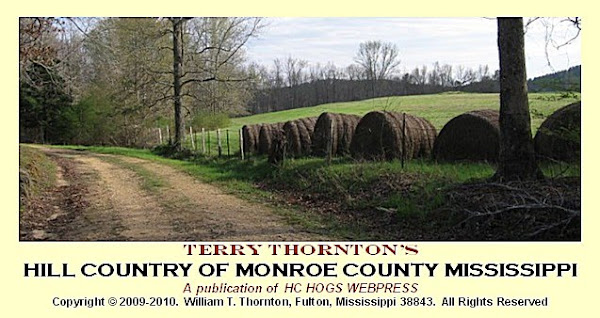The recent article (March 16, 2010) on Knowles Cemetery (click to read) contained an inventory of the names from the grave markers found in the old burial ground overlooking Halfway Creek. Reader and Monroe County historian Mary Anna Riggan sent the following article which explains how the cemetery was started on Crump property, how the first burial of Mr. Stanton there came about, and how the Knowles from Rhode Island came to the Hill Country during the early development of the county. The first marker in that cemetery survives --- and marks the grave of the individual in Mrs. Riggan's essay.
TRAGEDY IN HILL COUNTRY
by Mary Anna Riggan
It was probably warmer than usual on May 25, 1840 in Monroe County, Mississippi. Seemingly there had been plenty of rain during the winter so the mighty Tombigbee River was flowing deep, churning up silt, and was very inviting to the locals. The area close to the thriving town of Cotton Gin Port was known as a “wash hole” and a place for fun and frolic.
Abel Stanton and a group of his friends were there that day for whatever reason.
Abel Stanton, born April 24, 1804 in Rhode Island, was twenty-six years old when he wascommissioned by his Knowles Cousins to scout out the new lands that were opening up in Mississippi. The Benjamin Knowles family of Kingsport, Rhode Island, blessed with eleven children, had literally out-grown their land holdings. Benjamin decided the only way for all to survive was for the six oldest of his sons to migrate south to northeast Mississippi where new land was available through the recent Chickasaw Session.
It is said Abel traveled by boat from Rhode Island along the eastern seaboard, connecting to the Tombigbee River at Mobile. His journey upriver ended at Cotton Gin Port. Abel found everything to his likin’, so he set about establishing his own business and has been described as an industrious young merchant. He sent favorable word to his Knowles Cousins and encouraged them to join him.
Abel married Jane Crump on May 3, 1835. Jane’s father was John Crump, who was in Monroe by ~1830 or 1832. John had large land holdings, most of which were near or along either side of the Cotton Gin to Columbus Road (which we know as Old MS Hwy 25). For this narrative, the parcel of interest was south of Halfway Creek in S31 T13S R18W -- just north of where John Crump built his family home.
The Knowles Cousins arrived around 1836. After they settled in, Abel partnered with them, thus the business became Stanton and Knowles. Marriages and births took place at Cotton Gin Port.
As reported by a Stanton family researcher and suggested by the 1840 census, Abel and Jane had a son before 1840 and named him John.
Another family living at Cotton Gin Port at this time was that of Ezekiel “Zeke” Morgan. According to tax records, Zeke had been in Monroe since 1820/1821. He was married and hadtwo children. It is written that Zeke was a cabinet maker by profession, was a mechanicalgenius, and made all of his own tools. Everything he made was of superior workmanship. W. B. Wilkes describes him as “regarding his own opinion as the law to himself”…“He cared nothing for the opinions of anybody.” …and “would work at nothing longer than he was interested in it.”
Possibly Abel Stanton and his friends weren’t aware of the “contradictory” character of the person they were teasing at the “wash hole” on that fateful day in May. Some accounts report “horse play” turned into mud slingin’... reportedly both literally and vocally. Whichever the case, the young men tried to involve this fella’ in their fun.
He didn’t wanta’ play.
There are several versions of what happened that day, but the outcome of all the versions was tragic. It seems without reservation, Zeke Morgan picked up his gun and shot Abel Stanton.
In an instant, Jane Stanton was left a widow and little John was fatherless. There weren’t any formally plotted cemeteries at Cotton Gin at that time, so where were they going to bury Abel?
John Crump offered the answer. A small plot of ground just north of the Crump home was the chosen place. The land was owned by John Crump, the first burial was that of John Crump’s son-in-law, Abel Stanton, but the cemetery has been known though the ages as the Knowles Cemetery.
It’s bittersweet to note that on January 13, 1841, a new “twig” appeared on the Stanton family tree. Jane Crump Stanton named him Abel.
Sources: Monroe County History, Mother Monroe, Cemeteries of Monroe County, MS, 1820-1850 US Censuses of Monroe County, MS, Monroe County Land Records
Copyright © 2010. Mary Anna Riggan. Lackey, Mississippi. All Rights Reserved. Printed at Hill Country by permission of the author.

No comments:
Post a Comment